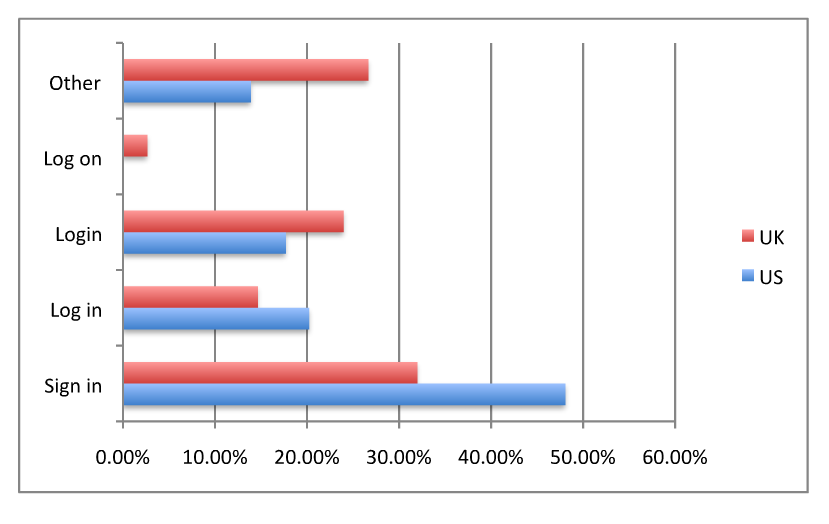We do it dozens of times a day, every day, but why do we call it logging in?
“Log in” is one of those phrases that sounds weirder the more you say it. It’s ubiquitous in online life, though it does seem like it’s being slowly overtaken by “sign in” [note 1]. But where does the phrase come from in the first place?
Clearly, a job for the Oxford English Dictionary. Luckily you can usually access the online OED through your local public library site. Thanks, libraries!

Representative terminal, not actually a CTSS terminal, CC LevitateMe
The OED’s earliest listed usage of “log in” in the modern sense of “to open one’s on-line access to a computer” is from the 1963 publication Compatible Time-Sharing System from the MIT Computation Center. [2] I’m not sure if this is truly the first usage of “log in”, but it would make sense if it was, as CTSS, started in 1961, was arguably the first time-sharing operating systems, and so possibly the first system that you needed to log in to. (Before that we only had batch processing systems).
Whether it was CTSS or a similar system, I envision an engineer, probably at MIT, somewhere between 1959 and 1961, needing to describe a new user command for the system they were creating.We get a lot of neologisms from these situations, and it’s very possible log in dates from just this moment in history.

CTSS Timeshare: A Programmer’s Guide, MIT press
It’s also possible that “log in” was used in a non-computer sense before time-share systems, but I haven’t seen it in print. But of course the “log” part, meaning to record something or someone, predates computers by hundreds of years.

Ship’s log CC David Churbuck
That usage is in turn a shortening from entering something into a “log-book”, or ship’s log, (or captain’s log, if you’re in Starfleet) which the OED defines as:
A book in which the particulars of a ship’s voyage (including her rate of progress as indicated by the log) are entered daily from the log-board.
The first listed usage of log-book or logbook is from roughly 1689 ( J. Moore’s New Syst. Math). By travelling back 250 years in time, we’ve gone from identifying ourselves within a computer system to entering the speed of a sailing ship into a book.
But why was it called a logbook? Because of this apparatus here, variously called a chip log, ship log, or log:

Chip log log line, & reel, CC Kate’s Photo Diary
A log! Or at least, a piece of heavy wood, attached to a knotted rope. Which you throw overboard and time how many knots go by for a set period of time, or, as Wikipedia describes it:
When the navigator wished to determine the speed of his vessel, a sailor dropped the log over the stern of the ship. The log would act as a drogue and remain roughly in place while the vessel moved away. The log-line was allowed to run out for a fixed period of time. The speed of the ship was indicated by the length of log-line passing over the stern during that time.
This is also why we still measure nautical speed in knots. So, when you next log in to Facebook or Gmail, think about big hunks of wood being thrown off the side of a ship to measure speed.
P.S. This was fun and entertaining for me to put together, but I’m sure there are holes and inaccuracies. If you know more about the origins of “log in”, please chime in with comments, and I’ll update accordingly!
Update 8/6/11: In a comment, Andrew Durdin points to some non-computer uses of “log in” from the 1950s. Awesome!
Note 1: A couple of years ago I did a survey of top websites in the US and UK and whether they used “sign in”, “log in”, “login”, “log on”, or some other variant. The answer at the time seemed to be that if you combined “log in” and “login”, it exceeded “sign in”, but not by much. I’ve also noticed that the trend toward “sign in” is increasing, especially with the most popular services. Facebook seems to be a “log in” hold-out. 
If the whole “sign in” vs. log in” debate is interesting to you, there are some debates here and here. My personal feeling is that either is fine, but “sign in” is marginally more friendly and probably the preferred usage, though I’ll miss the nautical association. On the other hand, I feel strongly that “login” as a verb is an abomination and not to be tolerated under any circumstances.
If you’re really interested, you might start noticing where sites show their own evolutions and inconsistencies of usage. For example, Twitter’s web UI uses “sign in” but the URL says “login”. But now we’re probably reaching the outer limits of obsession and should stop.
Note 2. Here’s a PDF of a CTSS manual from 1964. There’s an underlined “log in” on page 6.
Interestingly, CTSS is also the system that gave us the first email system, as described by Errol Morris in his history of his brother’s role in the creation of that system. The Wikipedia history of CTSS is pretty fascinating stuff as well, and contains links to oral histories of the creation of CTSS and Multics (the precursor to Unix).
This is an awesome post. Well done.
“It’s also possible that “log in” was used in a non-computer sense before time-share systems, but I haven’t seen it in print.”
It was, and the sense is very similar, but less specific and less fixed than the computer sense we are familiar with. The connection is from a ‘log’—the record of events occurring—and ‘log … in’ meaning to record an event in this log:
“Every phone call, every brief visit by a client, every moment spent was logged in.” ABA Journal, Jul 1956 — http://books.google.com/books?id=Fd7rG-ZS8RIC&pg=PA675&dq=%22logged+in%22&hl=en&ei=ovQ8TpycOIaWOtDvjPYH&sa=X&oi=book_result&ct=result&resnum=19&ved=0CHUQ6AEwEg#v=onepage&q=%22logged%20in%22%20-saw%20-sawdust%20-lumber%20-timber%20-fire&f=false
“The PBY message had been logged in at 7” LIFE, Dec 3, 1956 — http://books.google.com/books?id=xkEEAAAAMBAJ&pg=PA182&dq=%22logged+in+at%22&hl=en&ei=Gfc8TqGHJsmg8QPX_dD2Ag&sa=X&oi=book_result&ct=result&resnum=2&ved=0CDIQ6AEwAQ#v=onepage&q=%22logged%20in%20at%22&f=false
This usage naturally extended to recording the arrival and departure of persons from controlled spaces:
“Mr. Eisenhower was logged in at LaGuardia at 6:55 P.M.” The New Yorker, Volume 34, 1958 — http://books.google.com/books?id=9m8iAQAAMAAJ&q=%22logged+in+at%22&dq=%22logged+in+at%22&hl=en&ei=Gfc8TqGHJsmg8QPX_dD2Ag&sa=X&oi=book_result&ct=result&resnum=6&ved=0CEIQ6AEwBQ
“Culombe was logged in at the jail between 8 and 9 that night.” United States Supreme Court reports, Volume 6, 1960 — http://books.google.com/books?id=XUM3AAAAIAAJ&q=%22logged+in+at%22&dq=%22logged+in+at%22&hl=en&ei=Gfc8TqGHJsmg8QPX_dD2Ag&sa=X&oi=book_result&ct=result&resnum=11&ved=0CFMQ6AEwCg
I could only find one occurrence of “logged out” to mean making a record of departure (out of three hits for “logged out at”):
“The Victory left at 3:15 am EST on Saturday, October 1, and the White was logged out at 3:30 am.” Skillings’ mining review, Volume 44, 1955 — http://books.google.com/books?id=lNk3AQAAIAAJ&q=%22logged+out+at%22&dq=%22logged+out+at%22&hl=en&ei=wfc8TrnwCI7pOamWyesH&sa=X&oi=book_result&ct=result&resnum=1&ved=0CC8Q6AEwAA
With a little more searching, I hit the jackpot:
“Customers log in and out on a time clock.” Data processing digest, Volume 6, 1960 — http://books.google.com/books?id=CrUSAQAAMAAJ&q=%22log+in%22&dq=computer+%22log+in%22&hl=en&ei=5fg8TpKhAcil8QOp-JTpAg&sa=X&oi=book_result&ct=result&resnum=20&ved=0CHQQ6AEwEw
This shows that “log in” and “log out” were used more or less synonymously with the more common “clock in” and “clock out”, referring to timekeeping. More importantly, it shows the syntactic shift from *“the attendant logged in the customer” to *“the customer logged in” in the case where the log-keeping mechanism is automated, and operated by the person arriving or departing.
The story about the ship also relates to “blog”, a “book” where daily experiences are narrated. Earlier in time it was the captain describing the trip. Now it’s people talking about their cats.
In fact, in 2004/2005, there were many blogs that instead of “blog” were called something else which right now I can’t remember. It was 2 words “b…..” and “log”.
Maybe in terms of the time-sharing system, the reason to use the term “login” is not so much to mean “entering a computer system” but to “log” the beginning and the ending of the usage of the system, like at a factory with an old check-in/out card.
Andrew: that’s wonderful! I’ll update the post accordingly. I’d seen pretty early references to “logging” someone (often putting them down on a list for punishment), but your finds are spot on.
Blah – yes, the word “blog” is the result of shortening the original term “web log”.
Now I kind of want to change my Submit buttons to read “Ahoy”.
It’s so funny to me that you guys see this is a revelation. I have *always* thought that ‘log on’ and ‘log off’ referred to some archaic practice where you documented the start and end time of your session, probably for billing purposes. That is, you ‘log the time you got on’ and ‘log the time you got off’. Shows how unobvious some obvious things can be.
I prefer “log in” to “sign in” as “sign in” is very similar to “sign up” which some sites use instead of “register”. For non-native English speakers, the difference between “sign in” and “sign up” is subtle and may require conscious thought (as in my case) or be lost entirely.
Use “log in” and “register” for international audiences.
@Blah: “Blog” is an abbreviated form of the portmanteau of “web” and “log”: “weblog”. That’s it. It’s not even that old.
But if schools are no longer teaching cursive handwritting, is the phrase ‘sign in’ also anachronistic? Especially on a computer… with a keyboard?
On the University of Michigan Timesharing System in the 70’s, users had an account with a monetary value which decreased as they used the system. You couldn’t $signin without money.
The Penny Cyclopaedia of the Society of Diffusion of Useful Knowledge, published in 1834, explains the use of the “log” and “Log line” to determine the velocity of a ship’s motion through the water. The log was a flat piece of wood, sometime shaped like a fish, but more generally of the figure of a quadrant, loaded with lead at one of its edges to make it float upright. About 20 to 30 yards from point of the line’s attachment to the log, little pieces of knotted twine were rove into the line every 50 feet. A red flag was attached to the line, and as soon as the flag on the line left the reel holding the line, a distance to assure that the log had landed and was stationary in the water, a half minute sand glass was turned, and when the sand ran out, the reel for the line is stopped and the knots that left the reel were counted. The procedure was done hourly on a well regulated ship. The number of knots was recorded on a “log-board”, which was a large plank of wood, blackened, ruled and prepared for writing. Chalk was used to record the number of knots and other remarks on the log board. Every 24 hours or so, the info on the log board was put into the permanent record of the ship called the log book, and including other pertinent details of the voyage noted for each entry. The log board was erased and reused for the next reading. The 1834 account states: “Although, strictly speaking, the log-book is confined to these objects [recording knots and landmarks to determine the ship’s progress and location] it is usual to include under the same appellation the whole of the ship’s journal or diary of occurrences.” It doesn’t take much to associate the entry of info into the log book as an act intending to “log-in”.
And Now For Something Completely Different – This is an interesting article. The concept that caught my attention was the term “log line” used to measure the ship’s speed. In screenwriting, we generate a log line which is a very short (usually one sentence) description of the story used to hook a producer. What’s interesting is that a ship’s log line that was short would indicate very slow travel (very few knots), while the purpose of a screenwriter’s log line (one sentence) is to get the interest of your reader as quickly and concisely as possible.
I have no evidence other than my own intuition, but I came across a French phrase that struck me as a potential source for the Log in / Log out usages. At the Élysée Palace – the French President residence & office – the Concierge used to be in charge of the security and to monitor all arrivals and departures. The file where the I/O are logged (:-)) is called the ‘Fichier des loges’ where ‘loges’ is the slang for ‘concierge apartment’… It is probably just a coincidence, or is it?